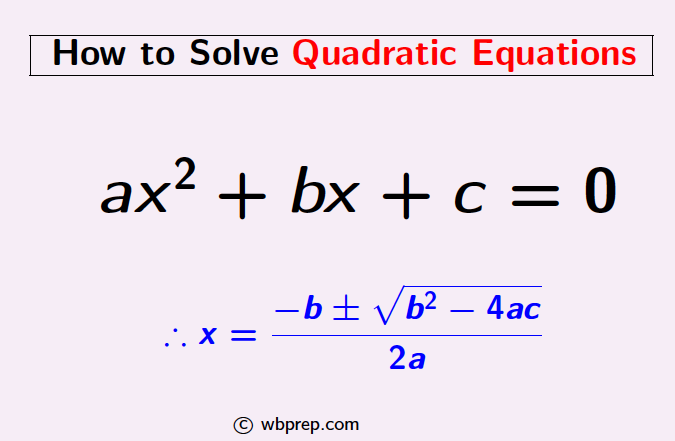There are many techniques for how to solve quadratic equations. For example, we can solve a quadratic equation by factoring or directly using the quadratic formula. In this post, we will learn about the same.

Solving Quadratic Equations using Factoring
To solve a quadratic equation using the factoring method, we will follow the below steps given below:
- First, write down the given equation in the standard form, (i.e., ax2 + bx + c = 0) in which one side contains the variable and constants, and the other side will be zero.
- Next, factor the expression of the non-zero side.
- Equate each of the factors of the previous step with 0. This is because a product of non-zero factors is zero if and only if one or more of the factors is 0.
- Solve each equation obtained in Step 3.
EXAMPLE 1:
Solve the equation x2 -5x + 6 = 0.
Solution:
First, factor x2 -5x + 6. See that
x2 -5x + 6
= x2 -3x -2x + 6
= x(x-3) -2(x-3)
= (x-2)(x-3)
So the solution of x2 -5x + 6 = 0 are given by
x-2=0 or x-3=0
⇒ x=2, 3
Thus, x=2,3 are the solutions of x2-5x+6=0.
Steps to Solve a Quadratic Equation
The general method of solving a quadratic equation is described below. The steps are as follows:
- First, express the given equation in the standard form: ax2 + bx + c = 0, where a, b, c are constants and x is the variable.
- Next, check whether ax2 + bx + c can be factored or not. If it is, then follow the steps given above.
- If ax2 + bx + c cannot be factored, then we proceed as follows:
ax2 + bx + c =0
⇒ $a \left(x^2 + \dfrac{b}{a}x + \dfrac{c}{a} \right) =0$
⇒ $x^2 + \dfrac{b}{a}x + \dfrac{c}{a} =0$ as a is non-zero; otherwise, the given equation won’t be quadratic.
⇒ x2 + 2⋅x ⋅$\dfrac{b}{2a}$ + $(\dfrac{b}{2a})^2$ – $(\dfrac{b}{2a})^2$ + $\dfrac{c}{a}$ =0
⇒ [x2 + 2⋅x ⋅$\dfrac{b}{2a}$ + $(\dfrac{b}{2a})^2$] – $\dfrac{b^2}{4a^2}$ + $\dfrac{c}{a}$ =0
⇒ $\left(x + \dfrac{b}{2a} \right)^2$ – $\dfrac{b^2-4ac}{4a^2}$ =0 using the formula a2+2ab+b2=(a+b)2
⇒ $\left(x + \dfrac{b}{2a} \right)^2$ = $\dfrac{b^2-4ac}{4a^2}$
Taking square roots on both sides, we get that
x + $\dfrac{b}{2a}$ = ± $\dfrac{\sqrt{b^2-4ac}}{2a}$
⇒ x = – $\dfrac{b}{2a}$ ± $\dfrac{\sqrt{b^2-4ac}}{2a}$
⇒ x = $\dfrac{-b \pm \sqrt{b^2-4ac}}{2a}$ …(∗)
So the solutions of the given equation ax2 + bx + c = 0 are x= [-b+√(b2-4ac)]/2a and [-b-√(b2-4ac)]/2a. This method of solving quadratic equations is known as Shreedhara Acharya’s formula, named after the ancient Indian mathematician Shreedhara Acharya who derived it. ♣
Let us now understand the above Shreedhara Acharya’s formula for solving a quadratic equation.
EXAMPLE 2:
Solve the equation x2 + x + 1 = 0.
Solution:
Comparing the given equation x2 + x + 1 = 0 with ax2 + bx + c = 0, we get that
a=1, b=1, c=1.
By the above Shreedhara Acharya’s formula (∗), the solutions of x2 + x + 1 = 0 will be
x = $\dfrac{-1 \pm \sqrt{1^2-4\cdot 1\cdot 1}}{2\cdot 1}$
= $\dfrac{-1 \pm \sqrt{-3}}{2}$
= $\dfrac{-1 \pm \sqrt{3}i}{2}$
So the solutions of x2 + x + 1 = 0 are $\dfrac{-1 + \sqrt{3}i}{2}$ and $\dfrac{-1 – \sqrt{3}i}{2}$, where i=√-1 is an imaginary complex number.
ALSO READ:
How to solve a linear equation
FAQs
Q1: How to solve a quadratic equation?
Answer: A quadratic equation can be solved by either factoring or by the quadratic formula (Shreedhara Acharya’s formula).
Q2: What is Shreedhara Acharya’s formula for solving quadratic equations?
Answer: The solutions of the equation ax2 + bx + c = 0 are x= [-b+√(b2-4ac)]/2a and [-b-√(b2-4ac)]/2a. This formula is known as Shreedhara Acharya’s formula.